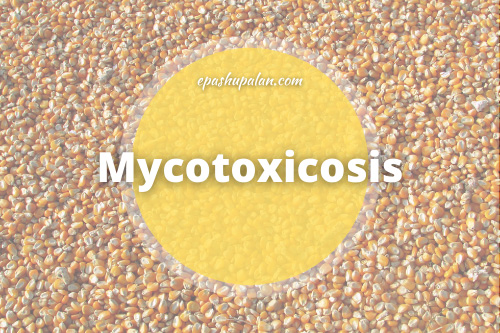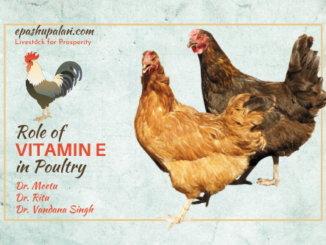Introduction
Mycotoxins are biologically active, toxic metabolites produced by toxigenic fungi mainly belonging to Aspergillus, Fusarium and Penicillium species, which invade crops in the field and may grow on foods during storage under favourable conditions of temperature and humidity. The Food and Agriculture Organization estimated that about 25% of human foods and animal feeds are contaminated with mycotoxins and strong efforts have been made to decontaminate them by the use of physical and chemical adsorbents but the success made so far is limited. Like other environmental pollutants, mycotoxins also adversely affect the health and productivity in animals and poultry. In India, the economy of poultry industry is heavily affected due to wide mycotoxin exposure or contamination of various agricultural commodities.

The poultry industry’s economy in India has been severely harmed as a result of widespread mycotoxin toxicity or contamination of different agricultural commodities. The economic losses are mainly attributed to decreased growth rate, feed conversion effectiveness, carcass yield, carcass condition, and increased susceptibility to other diseases among the infected birds as a result of their immunosuppressive impact. Aflatoxins (AF), citrinins (CIT), fumonisins (F), ochratoxins (OT), and tricothecenes are the most prevalent and essential mycotoxins in poultry, with over 350 found in nature.
Susceptibility to mycotoxins varies greatly depending on species, age, sex, and diet. Acute mycotoxicoses can even result in severe and even fatal diseases. When a severe acute illness strikes a large population and there is no sign of contamination with a known etiological agent and the clinical image does not change after treatment, mycotoxin poisoning should be regarded.
Commonly occurring mycotoxicoses in poultry
Aflatoxicosis
The most common mycotoxin developed by Aspergillus flavus and A. parasiticus, Aflatoxins B1 (AFB1), is primarily hepatotoxic and secondary nephrotoxic in poultry. Aflatoxins is already deemed a possible human carcinogen by the World Health Organization’s International Agency for Research on Cancer. Because of the damage to the thymus and bursa of Fabricius caused by aflatoxins, the birds are more vulnerable to infections like colibacillosis, chronic respiratory disease, and Ranikhet disease.
Aflatoxins are also responsible for a vaccine’s weak immune response and causes a decrease in egg production and poor hatchability in layers. The significant microscopic lesions include bile duct epithelium hyperplasia, degenerative and necrotic changes in hepatocytes, nodular hyperplasia of liver parenchyma with infiltration of polymorphonuclear lymphocyte cells in portal tracts, besides considerable changes in kidneys.
In India and Kenya, AFB1 has caused several outbreaks of acute aflatoxicosis with high mortality rates (10–60%), the most recent occurring in Kenya in 2004. The initial symptoms are high temperature, vomiting, and abdominal pain followed by anorexia, depression, jaundice, diarrhea, and photosensitivity. If exposure continues, jaundice progresses rapidly with hepatosplenomegaly, ascites, and coma. At postmortem the main lesions are consistent with acute liver injury.
Citrinin toxicosis
Citrinin (CIT), a nephrotoxic mycotoxin produced by Penicillium citrinum, has been implicated as a causal factor for endemic nephropathy in poultry species as a co-contaminant of various food commodities in poultry feed. In different animal species, it has also been reported to be embryotoxic, immunotoxic mycotoxin, neurotoxic, and teratogenic. CIT tends to have a primary action in the kidney, causing degenerative and necrotic alterations in renal tubular epithelial cells. Hepatic degeneration and sinusoidal congestion can be the cause of the liver’s enlargement and rise in relative weight during CIT toxicity in poultry.
Fumonisins toxicosis
Several fumonisins have been isolated and described, but Fumonisin B1 (FB1), which is primarily produced by the fungus Fusarium verticillioides, remains the most toxic. FB1 has been shown to occur spontaneously in corn and to cause major toxicity in a variety of avian species, with the main pathological alterations being multifocal hepatic necrosis and hepatocellular and biliary hyperplasia in the liver. Furthermore, the nephrotoxic effect of FB1 was investigated, with changes in the proximal convoluted tubule (PCT) lining cells being the most prominent and consistent. In turkey poults, FB1 has been shown to impair performance and immune function.
Fumonisins are also associated to a possible risk of human neural tube defects in communities in South Africa, China, and other parts of the world that consume fumonisin-contaminated maize. Fumonisins have been linked to an increased risk of oesophageal cancer in humans in South Africa. The International Agency for Research on Cancer identified the F. verticillioides toxin as a category 2B carcinogen, meaning it is potentially carcinogenic to humans, based on existing information on its toxicity and carcinogenicity.
A single outbreak of acute foodborne disease possibly caused by fumonisin was reported in 27 villages of the Deccan plateau in southern India during October 1995 affecting 1,424 people. The outbreak was a sequel to the damage to maize and sorghum crop by two cyclonic storms, which had occurred in quick succession resulting in unseasonal rains during the harvest season. The people who were affected were from the lowest socioeconomic classes. Transient stomach pain, borborygmus, and diarrhoea were the major symptoms of the illness, which appeared half an hour to an hour after eating unleavened bread made from mouldy sorghum or maize. When the exposure ended, the patients recovered fully, and there were no deaths.
Ochratoxicosis
Aspergillus ochraceus and Penicillium verrucosum contain ochratoxin A (OTA) in a wide range of climates and geographical regions. Ducklings tend to be the most susceptible birds to OTA in terms of LD50, followed by broiler chicks, White Leghorn chicks, Turkey poults, and Japanese quail chicks. In different animal species, OTA is a carcinogenic (Group 2B carcinogen), embryotoxic, genotoxic, hepatotoxic, immunotoxic, nephrotoxic, neurotoxic, and teratogenic mycotoxin. Anemia, diminished skeletal integrity, impaired blood coagulation, impaired phagocytosis, and reduced growth rate are all common symptoms in poultry, in addition to nephropathy. It has been found to be embryotoxic and teratogenic in Japanese quail. OTA is considered as the most toxic mycotoxin for domestic fowl studied so far.
A dry and firm gizzard has been found, along with mucosal erosions, catarrhal enteritis, dehydration, an emaciated carcass, and proventriculur mucosal haemorrhages. Kidneys swell, grow enlarged, pale, and swollen, and their colour changes from mahogany to tan. The liver is swollen, friable, or hemorrhagic, and pale. Urates build up in large amounts on the serosal surface of most organs. The tibiotarsal bones’ breaking strength and diameter are significantly reduced. Another symptom is increased intestinal fragility, which can lead to rupture. Kidney swelling and colour changes have been identified as one of the most common symptoms.
Trichothecenes toxicosis
Trichothecenes, a group of over 100 fungal metabolites with the same basic structure, are produced by a number of species of the genus Fusarium. They are common contaminants of poultry feeds and feedstuffs and can produce adverse effects on poultry health and productivity. T-2 toxin has been the most extensively studied trichothecene in poultry.
The primary effect of T-2 toxicosis in young broiler chicks is buccal-oral ulcerations/necrosis. The three trichothecenes, croticin, diacetoxyscirpenol and T-2 toxin, cause oral necrosis and affect body weight gain in growing chicks. It is generally regarded that the presence of oral lesions in poultry is the primary means of diagnosing trichothecenes toxicosis in the field. T-2 toxin is produced mostly in temperate climates and is associated with cereals that have been left to overwinter in the field. T-2 toxin has been linked to a number of animal toxicoses, as well as an outbreak of acute human mycotoxicoses.
In India, there is a scarcity of information on trichothecenes related mycotoxicoses in animals. Many acute disease outbreaks have been recorded in China and India as a result of DON exposure. The first human cases of trichothecene poisoning were recorded in Kashmir, India, in 1987, and were linked to the ingestion of mouldy flour bread. Fusarium spp., Aspergillus spp., and varying quantities of trichothecene mycotoxins were found as signs of mouldy wheat. T-2 toxin, as well as other trichothecenes such as DON, nivalenol, and DON monoacetate, were isolated from wheat flour. During the months of June to September 1987, a large portion of the Kashmir valley’s population was affected by a gastrointestinal condition that involved stomach pain, throat inflammation, diarrhoea, bloody stools, and vomiting.
Moniliformin toxicosis
Moniliformin is a Fusarium species’ water-soluble secondary metabolic product. This mycotoxin has been used as a contaminant in a variety of foods, including maize, wheat, barley, and other crops used in the production of poultry feed, all over the world. Moniliformin has been associated to severe cardiotoxicity in chickens, poults, and Japanese quails suffering from hypertrophic cardiomyopathy. Furthermore, it has been discovered that it harms the liver and kidneys of poultry birds.
References
- Ditta Y A, Mahad S and Bacha U. 2018. Aflatoxins: Their Toxic Effect on Poultry and Recent Advances in Their Treatment. Mycotoxins – Impact and Management Strategies, 125-47.
- Patil R D, Sharma R and Asrani R K. 2014. Mycotoxicosis and its control in poultry: A review. Journal of Poultry and Technology, 2(1), 1-10.
- Maja Peraica. Outline of Fungal Pathologies, 47.49.
- Raghavender C R and Reddy B N. Human and animal disease outbreaks in India due to mycotoxins other than aflatoxins. World Mycotoxin Journal, 2(1), 23-30.






Be the first to comment